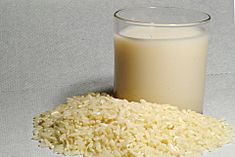Rice milk facts for kids
 |
|
| Nutritional value per 100 g (3.5 oz) | |
|---|---|
| Energy | 195 kJ (47 kcal) |
|
9.2 g
|
|
| Sugars | 5.3 g |
| Dietary fiber | 0.3 g |
|
1.0 g
|
|
|
Protein
|
0.3 g
|
| Vitamins | Quantity
%DV†
|
| Thiamine (B1) |
3%
0.03 mg |
| Riboflavin (B2) |
1%
0.014 mg |
| Niacin (B3) |
3%
0.4 mg |
| Pantothenic acid (B5) |
3%
0.15 mg |
| Vitamin B6 |
3%
0.04 mg |
| Folate (B9) |
1%
2 μg |
| Vitamin B12 |
26%
0.63 μg |
| Vitamin C |
0%
0 mg |
| Vitamin D |
7%
1 μg |
| Vitamin E |
3%
0.47 mg |
| Vitamin K |
0%
0.2 μg |
| Minerals | Quantity
%DV†
|
| Calcium |
12%
118 mg |
| Copper |
2%
0.04 mg |
| Iron |
2%
0.2 mg |
| Magnesium |
3%
11 mg |
| Manganese |
13%
0.28 mg |
| Phosphorus |
8%
56 mg |
| Potassium |
1%
27 mg |
| Sodium |
3%
39 mg |
| Zinc |
1%
0.13 mg |
| Other constituents | Quantity |
| Water | 89.3 g |
|
Link to USDA Database entry
|
|
| †Percentages estimated using US recommendations for adults. | |
Rice milk is a popular drink made from rice. It's a type of plant milk, meaning it comes from plants, not animals.
Most rice milk you buy is made from brown rice. Sometimes, it's sweetened with sugar or other sweet things. Flavors like vanilla are often added too. To make it healthier, companies often add extra protein and important nutrients. These can include vitamin B12, calcium, iron, or vitamin D.
Contents
The History of Rice Milk
The exact start of rice milk isn't fully known. In 1914, a recipe for rice milk appeared in a book called Meatless Cookery. This was one of the first times the name was used.
In 1921, the first factory to make rice milk opened. It was called Vita Rice Products Co. They launched their "Vita Rice Milk" in San Francisco, California, that same year. Later, in 1990, a brand called Rice Dream became very popular. It was sold in special cartons, making it easy for many people to buy.
What's in Rice Milk?
Unsweetened rice milk is mostly water (about 89%). It has about 9% carbohydrates and 1% fat. It doesn't have much protein.
A small serving (100 ml) gives you about 47 calories. If it's fortified, meaning extra nutrients are added, it can provide a good amount of vitamin B12. It also has some calcium and manganese. However, it's generally low in other important nutrients unless they are added during making.
Is Rice Milk Safe for Young Children?
Because of certain natural elements found in rice, experts suggest that rice milk should not be the main drink for children under 5 years old. It's not a full replacement for breast milk, formula milk, or cow's milk for very young kids.
Rice Milk vs. Cow's Milk
Rice milk has more carbohydrates than cow's milk. But it doesn't naturally have much calcium or protein. It also has no cholesterol or lactose.
Many brands of rice milk add extra vitamins and minerals. These often include calcium, vitamin B12, vitamin B3, and iron.
Rice milk is often a good choice for people with allergies. It's one of the least likely plant milks to cause an allergic reaction. People who can't digest lactose (lactose intolerant) or are allergic to soy or milk can often drink rice milk. It's also a popular choice for vegans who don't eat or drink animal products.
Popular Brands of Rice Milk
You can find many different brands of rice milk in stores. They come in various flavors, like vanilla, or plain (unflavored). You can use rice milk in many recipes as a substitute for regular cow's milk.
How Rice Milk Is Made
Commercial rice milk is made by grinding rice very finely. Then, it's filtered and mixed with water.
You can also make rice milk at home! You can use rice flour and rice protein. Another way is to boil brown rice with a lot of water, then blend it and filter the mixture.
Environmental Impact
Growing rice needs a lot of water, especially in rice paddies. These fields can sometimes let fertilizers and pesticides get into nearby water. Also, tiny living things in rice paddies release methane gas. Methane is a greenhouse gas that affects our planet's climate.
Compared to other milks, making rice milk uses less water than dairy milk and almond milk. However, it uses more water than soy milk or oat milk.
Gallery
See also
 In Spanish: Leche de arroz para niños
In Spanish: Leche de arroz para niños



